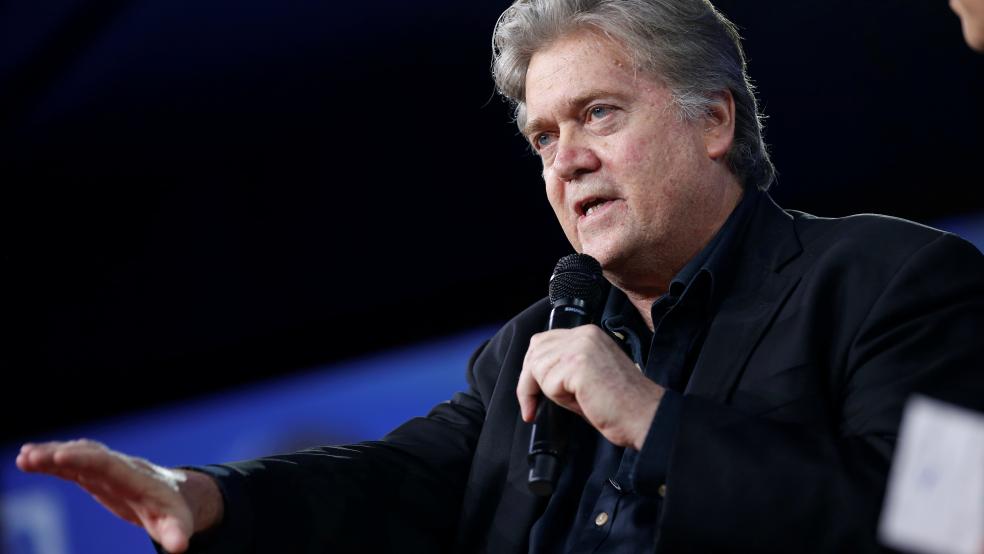The vice-chairman of the Federal Deposit Insurance Corp. floated a plan earlier this week that would require big banks to separate their commercial and investment arms — essentially a return to the 1933 Glass-Steagall Act that for decades kept the Citibanks of the world walled off from the securities business.
The FDIC’s Thomas Hoenig said in a speech to the Institute of International Bankers that investment activities and commercial banking, such as holding deposits and lending to consumers, should be handled by distinct units. In exchange, big banks would get looser capital and liquidity requirements.
On the campaign trail, Donald Trump often promised a return to Glass-Steagall and in a last-minute change last July, that position was inserted into the Republican Party platform, surprising many. At a press briefing last Thursday, Trump Press Secretary Sean Spicer said in response to a question that the administration remains committed to restoring Glass-Steagall.
Still, with so many former Wall Street players holding top positions in the Trump administration, any new iteration of Glass-Steagall would seem like a non-starter.
Related: Trump Calls for '21st Century' Glass-Steagall Banking Law
But there are several factors that could make a “Glass-Steagall for the 21st Century” — which Trump called for last October and which Treasury Secretary Steve Mnuchin said at his confirmation hearing should be considered — more of a possibility.
First, most of the Wall Streeters in the Cabinet or other positions of power — such as economic adviser Gary Cohn, Mnuchin and Commerce Secretary Wilbur Ross — do not come from the big commercial banks but from investment banks, which might actually benefit from not having behemoths such as Citi, Bank of America, JPMorgan Chase and Wells Fargo playing in their sand box.
In what may have been a telling moment, Mnuchin told the Senate that the Volcker Rule, a component of the Dodd-Frank financial reform act that restricts speculative investments by banks, should apply only to banks that benefit “from federal deposit insurance." That means big commercial banks and investment banks that also offer customers some commercial banking functions.
In addition, Trump confidant and early supporter Carl Icahn, the billionaire investor, called for a reinstatement of Glass-Steagall in a 2014 interview with Fox News.
Related: Trump the Populist Is Trying to Hobble a Champion of the Little Guy
Perhaps the biggest reason that the Trump administration could embrace a version of Glass-Steagall is influential adviser Steve Bannon. In a Wall Street Journal profile on Tuesday, the self-described economic nationalist talked about how the nest-egg losses his father suffered during the financial crisis of 2008 have informed his outlook. “Everything since then has come from there. All of it,” he said.
And in a video discussion at the 2014 annual conference of the Rome-based Human Dignity Institute, Bannon talked about a “crisis in capitalism” and complained that no one had been jailed because of the financial crisis. He said the big bank “bailouts were completely and totally unfair. It didn’t make those financial institutions any stronger, and it bailed out a bunch of people — by the way…people that have all gone to Yale, and Harvard, they went to the finest institutions in the West. They should have known better.”
Bannon said that seeing “all the upside [go] to the hedge funds and the investment bank[s] and to the crony capitalist[s] with stock increases and bonus increases” was part of what was fueling a populist uprising.
A November 2016 Journal story said that Bannon’s remarks suggested an endorsement of Glass-Steagall, though it remains unclear if he still holds those views. Still, Bannon ran Breibart News until he joined the Trump campaign late last summer, and during his tenure the right-wing news site on more than one occasion called for a return to Glass-Steagall.
Trump wasn’t the only candidate to call for a reinstatement of Glass-Steagall during last year’s election campaign; Democrat Bernie Sanders did, too. Both pointed out that the barriers between commercial and investment banks were broken down by legislation signed by former President Bill Clinton in 1999 — a clear jab at Hillary Clinton — and suggested that rolling back Glass-Steagall helped bring on the financial crisis, though economists and regulation experts are divided about its impact.
Related: Bill Clinton Still Can’t Fess Up to One of His Biggest Blunders
In a story last August, The Atlantic laid out the wide range of views. Former Labor Secretary Robert Reich wrote: “I’ve…heard bank executives claim there’s no reason to resurrect Glass-Steagall because none of the big banks actually failed. This is like arguing lifeguards are no longer necessary at beaches where no one has drowned.”
But John Berlau of the Competitive Enterprise Institute had a vastly different position. “Since Glass-Steagall forbade ‘Main Street’ commercial banks from venturing into investment banking, it actually protected Wall Street investment banks such as Bear Stearns and Goldman Sachs from competition, enabling them to get bigger.… And in the end, it was pure investment banks such as Bear and Lehman Brothers — neither of which had merged with commercial banks — that were the first dominoes to fall in the financial crisis.”
Reinstating the original structure of Glass-Steagall is probably not in the cards. Mnuchin said in January that “Separating out banks and investment banks right now…would have very big implications,” including, as Bloomberg noted, “potentially hurting liquidity, the capital markets and lending.” But he did endorse looking at new ways to wall off bank risk.
Today, Fed Chair Janet Yellen said she had seen no concrete proposals and didn’t know what a modern-day Glass-Steagall would look like. She also said: “I don’t think [rolling back Glass-Steagall] was the cause of the financial crisis,” adding that bank holding companies have been strengthened since the crisis and investment banking activities are now more appropriately capitalized. “But,” Yellen said, “obviously we would look at any proposals.”
One other thing might give the president pause: Two of his arch-enemies from both sides of the aisle, Democratic Senator Elizabeth Warren and Republican Senator John McCain have jointly proposed an update to Glass-Steagall.
If Bannon were to pick this fight, he would have allies — but also heavy resistance.





